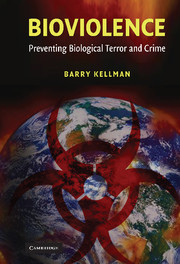Book contents
- Frontmatter
- Contents
- Prologue
- Foreword, by Ronald K. Noble, Interpol Secretary General
- Acknowledgments
- Introduction
- PART I THE BIOVIOLENCE CONDITION AND HOW IT CAME TO BE
- PART II THE GLOBAL STRATEGY FOR PREVENTING BIOVIOLENCE
- 4 Strategic Foundations
- 5 Complication: What Law Enforcers Should Stop
- 6 Improving Resistance through Science
- 7 Public Health Preparedness
- 8 International Nonproliferation
- 9 The Challenge of Global Governance
- Conclusion
- Notes
- Bibliography
- Index
8 - International Nonproliferation
Published online by Cambridge University Press: 27 July 2009
- Frontmatter
- Contents
- Prologue
- Foreword, by Ronald K. Noble, Interpol Secretary General
- Acknowledgments
- Introduction
- PART I THE BIOVIOLENCE CONDITION AND HOW IT CAME TO BE
- PART II THE GLOBAL STRATEGY FOR PREVENTING BIOVIOLENCE
- 4 Strategic Foundations
- 5 Complication: What Law Enforcers Should Stop
- 6 Improving Resistance through Science
- 7 Public Health Preparedness
- 8 International Nonproliferation
- 9 The Challenge of Global Governance
- Conclusion
- Notes
- Bibliography
- Index
Summary
State bioweapons programs are no longer the exclusive center of bioviolence concerns, having been eclipsed by threats from terrorists and criminals. Yet we dare not ignore State bioweapons threats both because States have unparalleled capacities for making bioweapons and because State programs can be the source (wittingly or not) for non-State bioviolence.
State threats pose unique challenges for devising a prevention strategy. There is not much to be gained by trying to deny States access to critical pathogens and equipment; these items are widely available. Most States could, on their own, make bioweapons today. Law enforcement interdiction of covert preparations is irrelevant; police will not pursue their own government's activities. Also, State use of bioweapons is apt to be of a size and scale to overwhelm even the best preparations. International nonproliferation measures must fill the space left thin by complication and preparedness measures.
From the perspective of preventing bioviolence, international nonproliferation means steadfastly reinforcing the global prohibition against bioweapons as a threat to international peace and security. It means that any State that develops or assists others in developing bioweapons must be unequivocally denounced as an international criminal, and any State that puts them to hostile use must know that it will suffer the harshest consequences permissible under international law. For international nonproliferation to be effective, States must be able to know whether other States are foregoing bioweapons, and there must be an objective process to investigate suspicious activity and to hold violators accountable.
- Type
- Chapter
- Information
- BioviolencePreventing Biological Terror and Crime, pp. 192 - 221Publisher: Cambridge University PressPrint publication year: 2007



